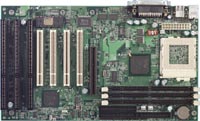Supermicro 370SBA i440BX Socket-370 ATX
by Mike Andrawes on July 22, 1999 8:08 PM EST- Posted in
- Motherboards
Supermicro is best known for their rock solid high-end server/workstation boards. Most of the time, these boards feature huge PCB's packed with all kinds of goodies, such as onboard SCSI. But what happens when Supermicro is presented with the "low-end" Celeron processor? You get the Super 370SBA - an i440BX Socket-370 ATX motherboard that its bigger brothers would be proud of.
Since Celeron's are intended for low cost computers, all thoughts of onboard SCSI were eliminated immediately. Second, the PCB would have to be small in order to lower the cost as much as possible. Fortunately, they didn't skimp elsewhere on the board as construction is impeccable.
New Anand Tech Report Card Rating 88/B
Do not compare newer ratings to older ones, the newer ratings are much more aggressive
| CPU Interface | Socket-370 |
| Chipset | Intel i440BX |
| L2 Cache | N/A (on-chip) |
| Form Factor | ATX |
| Bus Speeds |
66 / 68 / 75 /
83 |
| Clock Multipliers | Auto Detect |
| Voltages Supported | Auto Detect |
| Memory Slots | 3 168pin DIMM Slots |
| Expansion Slots |
0 AMR Slot |
| BIOS | AMI WinBIOS 2.5 |
The Good
The 370SBA looks much like any other Socket-370 ATX motherboard. The slightly dated 4/3/1 (PCI/ISA/AGP) expansion slot configuration was selected by Supermicro for this particular board. Three DIMM slots round out the expansion capabilities. High quality Molex and Foxconn connectors are used throughout the board. Although not shown in the picture at right, the traditional green heatsink keeps the 443BX Northbridge running nice and cool.
The ATX specification is also closely followed with all major components strategically placed to minimize cable clutter and provide the most room to work around the board. All HDD/FDD connectors are located where they should be, right at the front of the board, so that no cables are forced to run over the CPU and/or memory. The ATX power connector is unfortunately located at the back of the board, next to the CPU socket. That means that the power cable will have to run over the CPU and memory, reducing airflow to the CPU and cluttering up the inside of the system. The front panel connectors are wisely placed in front of all HDD/FDD connectors, meaning that all slots are capable of accepting full length cards.
Seven 1000uF capacitors help keep everything nice and stable, and they do an excellent job as the 370SBA matched the rock solid stability of the likes of AOpen and Gigabyte. What else would you expect from a company that focuses on high end server boards? It's good to know that they didn't cut any corners in the interest of lowered cost, especially given the target market. As we've seen time and time again, performance differences between i440BX boards is usually negligible, a fact that was confirmed by the 370SBA.
Complete hardware monitoring is included on the 370SBA through the Winbond 83781D chip, which monitors 3 fan speeds, 7 voltages, and up to 3 temperatures. The 7 voltages measured include the standard +/- 5V, +/- 12V, +3.3V, CPU core, and CPU I/O. Three 3 pin fan connectors are available for monitored fans - one next to the CPU socket and two more in front of the DIMM slots. One of the fan connectors next to the CPU socket is for a "thermally controlled fan" that, as the name implies, turns on when the CPU gets too hot (as set in the BIOS). On overheat LED also turns on at this point to warn the user of the potential problem. This is practically a Supermicro tradition that was fortunately not removed for this "low end" board.
The reason for "up to 3 temperatures" is that the Winbond hardware monitor can only monitor one temperature on its own - the temperature of the Winbond chip itself. In order to monitor the other two temperatures, such as that of the CPU, the Winbond chip requires an external thermistor. One thermistor is integrated in the CPU socket, but no additional headers are available. Supermicro includes their own hardware monitoring software, known as Super Doctor. Also on the included CD are complete manuals for a variety of Supermicro boards, chipset patches and busmaster drivers for Windows 95, Adobe Acrobat Reader, and a variety of drivers for other Supermicro boards. The manual is decent, and includes a nice trouble shooting section. Unfortunately, the descriptions of some of the more cryptic BIOS settings are not particularly helpful.
One of those cryptic settings, specifically "Manufacturer's Setting," is actually the way to get overclocked FSB speeds and all the manual says is "...for factory testing only." The available options are "Mode 0 - Mode 5". Mode 5 doesn't seem to work at all, but modes 0 - 4 give various FSB selections. Mode 0 is the default as detected by B21 and mode 1 provides the same speed (don't ask why it's there, we have no clue). Mode 2 is similar to the "turbo" setting in ABIT's SoftMenu, providing 68 or 103 MHz depending on the manufacturer specified CPU speed (66 or 100). Mode 3 is 75 or 112 and mode 4 is 83 or 124, again depending on the manufacturer specified CPU speed. A jumper on the board allows overriding the state of BSEL (commonly known as B21 on Slot-1 CPU's) to force either 66 or 100 MHz operation. Supermicro didn't include any jumpers or BIOS settings for clock multipliers since they are autodetected. This can be done quite easily since all Socket-370 CPU's are multiplier locked and any settings would be ignored anyway.











0 Comments
View All Comments